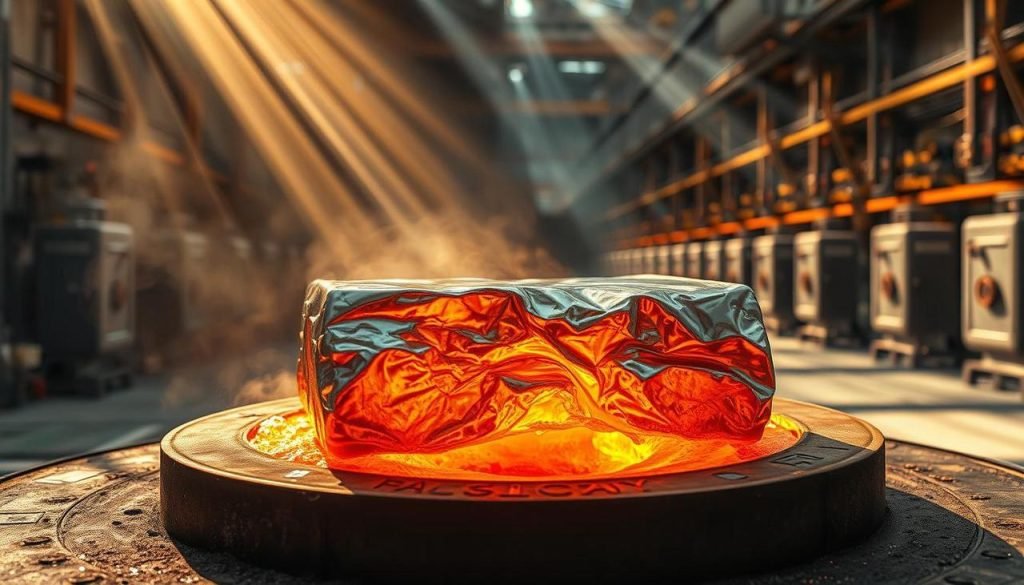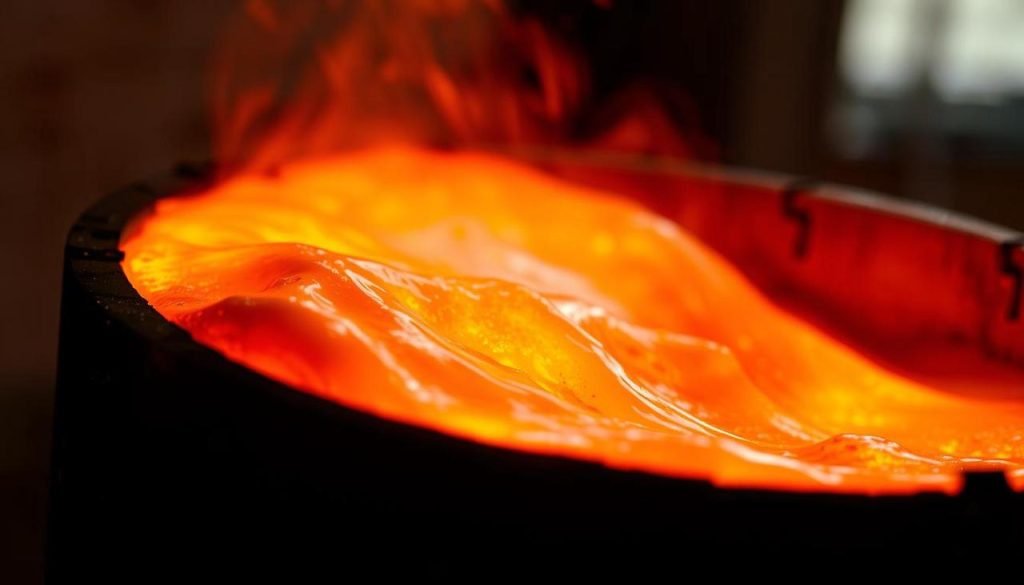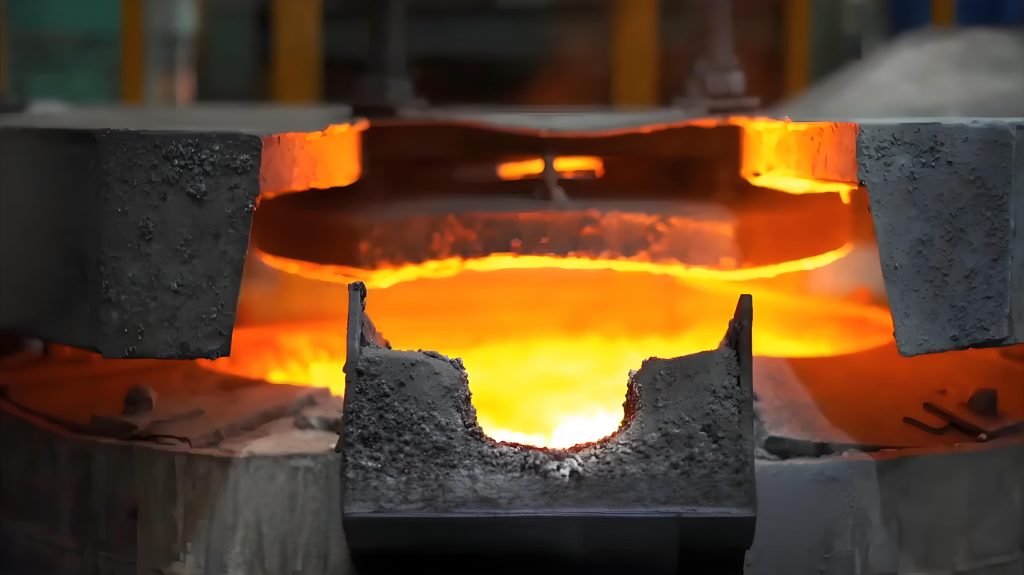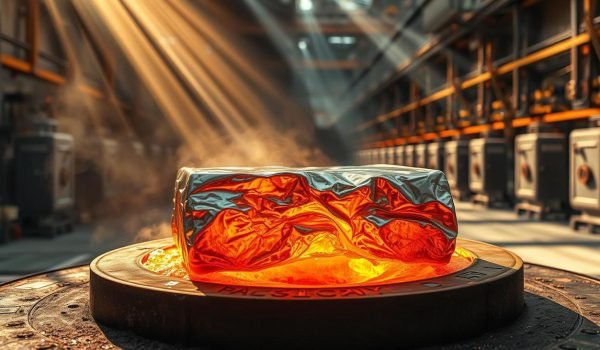You might be surprised to learn that pure aluminum has a melting point of 1220.58°F (660.32°C), but most industrial applications use aluminum alloys with significantly lower melting temperatures.
The melting behavior of aluminum is crucial for various manufacturing processes, including heat treatment, casting, extrusion, and welding. As you explore the world of aluminum applications, understanding its melting behavior becomes essential.
While aluminum’s strength-to-weight ratio and corrosion resistance are well-known, its melting point plays a vital role in high-temperature applications. In this article, we’ll delve into the fundamentals of aluminum melting, common alloy grades, and their temperature ranges, as well as factors affecting their melting behavior.

The Fundamentals of Aluminum Melting Point
To work effectively with aluminum, it’s essential to comprehend its melting behavior. The melting point of aluminum is a critical property that influences its application in various industries. You need to understand the factors that affect this property to make informed decisions in your projects.
What Defines the Melting Point of Aluminum
The melting point of aluminum is defined as the temperature at which it changes state from solid to liquid. Pure aluminum has a melting point of approximately 660.32°C (1220.58°F). However, this value can vary significantly when alloying elements are added to pure aluminum, creating aluminum alloys with diverse properties.
Pure Aluminum vs. Aluminum Alloys
Pure aluminum is rarely used in industrial applications due to its relatively low strength and high ductility. In contrast, aluminum alloys are widely used because they offer improved mechanical properties, such as strength and corrosion resistance, due to the addition of alloying elements like copper, manganese, and silicon.
| Alloy Series | Primary Alloying Elements | Melting Range (°C) |
| 1xxx | None (Pure Aluminum) | 660.32 |
| 2xxx | Copper | 500-650 |
| 3xxx | Manganese | 630-660 |
Understanding the difference between pure aluminum and aluminum alloys is crucial for selecting the right material for your specific application. The addition of alloying elements not only enhances the mechanical properties but also affects the melting behavior, creating a melting range rather than a single melting point.
Melting Point of Aluminum: Common Grades and Their Temperature Ranges
The melting behavior of aluminum alloys is a key consideration in industrial manufacturing. Different aluminum grades have distinct melting points, which significantly influence their applications and processing techniques.
Pure Aluminum Melting Temperature
Pure aluminum has a melting point of approximately 660.32°C (1220.58°F). This precise melting point is a critical characteristic that defines its applications and processing methods.
Wrought Aluminum Alloys and Their Melting Ranges
Wrought aluminum alloys are formulated for mechanical working processes such as rolling, forging, or extrusion. Their melting ranges vary depending on the alloying elements. For instance, the 6061 alloy, a popular wrought aluminum alloy, has a melting range of 582-652°C (1080-1205°F). These alloys are designed to offer a balance of strength, corrosion resistance, and weldability, making them suitable for a wide range of applications, from aerospace to automotive components.
Cast Aluminum Alloys and Their Melting Ranges
Cast aluminum alloys are specifically designed for casting processes where molten aluminum is poured into molds. Their melting ranges are optimized for flowability and mold filling. Common cast aluminum alloys include A360, A380, A413, and B390, with melting ranges as follows:
| Alloy | Melting Range (°C) | Melting Range (°F) |
| A360 | 557-596 | 1030-1100 |
| A380 | 538-593 | 1000-1100 |
| A413 | 574-582 | 1070-1080 |
| B390 | 510-649 | 950-1200 |
The A380 alloy, with its melting range of 1000-1100°F (538-593°C), is widely used in die casting for automotive components and consumer products due to its excellent castability. In contrast, the B390 alloy has a wider melting range of 950-1200°F (510-649°C), making it suitable for applications requiring high wear resistance, such as engine components.
Factors That Affect the Melting Point of Aluminum
Understanding the melting behavior of aluminum requires consideration of various influencing factors. The melting point of aluminum is not a fixed value; it can vary based on several conditions and elements present in the metal.

Alloy Composition and Its Impact
The composition of aluminum alloys significantly affects their melting points. Different alloying elements can either increase or decrease the melting point. For instance, adding silicon or copper to aluminum can alter its melting characteristics. The specific alloy composition determines the melting range rather than a single melting point.
Chemical Impurities and Melting Point Depression
Chemical impurities in aluminum can lead to melting point depression, where the presence of impurities lowers the melting point of the material. This effect is crucial in understanding the melting behavior of aluminum, especially in industrial applications where purity levels can vary.
Pressure and Environmental Conditions
Pressure and environmental conditions also play a significant role in determining the melting point of aluminum. According to Gay-Lussac’s Law, pressure and temperature are directly proportional. Pressures of up to 3500 gigapascals can increase the melting point, but beyond this range, the melting point may drop. Additionally, environmental conditions such as oxygen content and humidity can affect the melting behavior by influencing oxidation rates.
Controlled atmosphere environments are used in industrial aluminum melting operations to minimize oxidation and hydrogen absorption, which can affect both melting behavior and final product quality. Temperature gradients and heating rates also influence the effective melting behavior of aluminum components, particularly in processes like welding and heat treatment.
Heat Treatment Applications and Aluminum’s Melting Point
Heat treatment applications for aluminum rely heavily on precise control around its melting point. You need to understand how different heat treatment processes interact with the melting behavior of aluminum to achieve desired mechanical properties.
Annealing and Stress Relief Processes
Annealing involves heating aluminum to a specific temperature below its melting point and then cooling it to relieve stresses and make the material more workable. This process is critical for removing internal stresses that can lead to distortion or cracking during further processing or in service.
Solution Heat Treatment and Precipitation Hardening
Solution heat treatment involves heating aluminum alloys to a temperature where the alloying elements dissolve, followed by rapid quenching. Subsequent precipitation hardening at a lower temperature allows the formation of precipitates that strengthen the alloy. The temperature must be carefully controlled to avoid approaching the melting point.
Temperature Control Challenges in Heat Treatment
Maintaining precise temperature control is crucial during heat treatment. Challenges include ensuring temperature uniformity across complex geometries and managing heating and cooling rates to prevent distortion or cracking. Modern heat treatment equipment addresses these challenges with multiple temperature monitoring points and sophisticated control algorithms.
Casting Aluminum: Leveraging the Melting Point for Manufacturing
When it comes to manufacturing with aluminum, understanding the melting point is crucial for successful casting processes. You need to carefully manage the temperature to ensure that the aluminum is properly melted and formed into the desired shape.
Basics of Aluminum Casting Processes
Aluminum casting involves melting the metal to a temperature typically between 1300-1450°F (705-790°C) to avoid premature solidification. The molten aluminum is then poured into a mold, where it cools and solidifies into the desired shape. The process requires careful control of temperature and handling to produce high-quality castings.
Die Casting vs. Sand Casting Temperature Requirements
Die casting and sand casting are two common methods used in aluminum casting. Die casting requires precise temperature control, as the molten aluminum is injected into a metal mold under high pressure. Sand casting, on the other hand, involves pouring molten aluminum into a sand mold, which can be less precise in terms of temperature control. Understanding the melting point of aluminum is essential for both processes to achieve the desired outcome.

Safety Considerations When Melting Aluminum
Melting aluminum poses several safety risks, including severe burns, fires, and potential explosions. You must follow proper procedures to mitigate these risks. For instance, it’s crucial to dry and preheat all tools, additives, and scrap material before they come into contact with molten aluminum to prevent moisture-related explosions. Additionally, wearing proper personal protective equipment (PPE) such as face shields, heat-resistant clothing, gloves, and foot protection is essential. Modern foundries also employ safety systems, including moisture detection equipment and emergency response protocols, to minimize risks associated with molten metal incidents.
By understanding the melting point of aluminum and adhering to safety protocols, you can ensure a safe and efficient casting process.
Aluminum Extrusion: Temperature Management for Optimal Results
Aluminum extrusion requires a deep understanding of how temperature affects the material’s properties and the extrusion process. You need to heat a solid piece of aluminum until it softens before forcing it through a die to create the desired profile.
Pre-heating and Softening Before Extrusion
Pre-heating aluminum to the correct temperature is crucial for successful extrusion. The temperature range for pre-heating varies depending on the alloy, but it is typically between 800°F to 900°F (427°C to 482°C), which is below the
Temperature Ranges for Different Extrusion Profiles
Different extrusion profiles require specific temperature ranges to achieve optimal results. For instance, complex profiles may require more precise temperature control to prevent distortion or defects. You must consider the alloy’s properties and the profile’s geometry when determining the ideal temperature range.
Cooling Processes and Their Importance
Controlled cooling after extrusion is critical to prevent distortion and achieve the desired mechanical properties. Various cooling methods, including air cooling, water spray, or immersion cooling, can be used, each affecting the microstructure and properties of the extruded product. Quenching heat-treatable alloys immediately after extrusion prevents unwanted precipitation, and modern extrusion plants use sophisticated cooling systems to optimize cooling profiles.
Welding Aluminum: Working Below the Melting Point
Welding aluminum successfully hinges on knowledge of its melting characteristics and how to work below that threshold. You need to understand the melting behavior of aluminum to achieve high-quality welds.
TIG and MIG Welding Temperature Considerations
TIG and MIG welding processes require precise temperature control to prevent overheating and distortion. You must manage the heat input carefully to maintain the integrity of the aluminum alloy.
Preventing Distortion and Cracking During Welding
To prevent distortion and cracking, it’s crucial to select the right welding technique and parameters. You should also ensure proper joint preparation and fit-up to minimize stress concentrations.
Filler Materials and Their Melting Points
The choice of filler material is critical, as it must have a melting range compatible with the base material. For instance, 4043 (Al-Si) and 5356 (Al-Mg) alloys are commonly used, with melting ranges of 1065-1170°F (574-632°C) and 1050-1175°F (566-635°C), respectively. The composition of these fillers affects their melting behavior and suitability for different aluminum alloys.
Conclusion: Mastering Aluminum’s Melting Point for Industrial Success
To fully leverage aluminum’s potential, it’s vital to comprehend its melting point and its implications. Understanding the melting point of aluminum is crucial for various industrial applications, including heat treatment, casting, extrusion, and welding. Aluminum’s relatively low melting point compared to other structural metals offers both advantages, such as energy efficiency and processing ease, and challenges, including temperature limitations and distortion control.
Mastering aluminum’s melting behavior is essential for optimizing manufacturing processes and ensuring product performance in service environments. By selecting the appropriate aluminum alloy based on its melting characteristics, you can enhance the quality and reliability of your products. This understanding enables engineers and manufacturers to fully exploit aluminum’s potential across diverse industrial applications.




